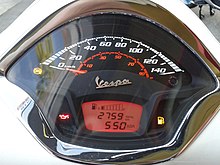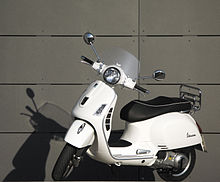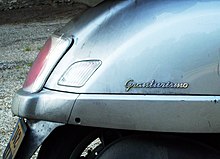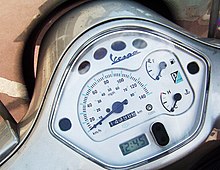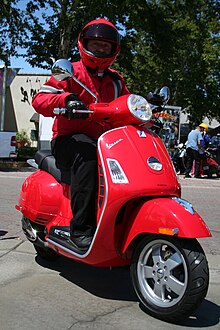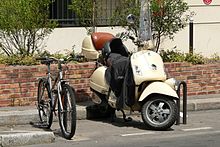Vespa GTS
The Vespa GTS is a motor scooter from the manufacturer Piaggio , which sells its classic product line under the brand name Vespa .
Model history
First series, GT
Spurred on by the success of the Vespa ET , Piaggio brought out the Vespa GT in 2003, turning away from previous design principles such as air-cooled two-stroke engines, foot brakes and manual transmissions, which gave the Vespa PX and Vespa Cosa their identity, for example . In addition to the design, only the sheet steel body was reminiscent of the past. At first viewed critically, the vehicles impressed with their high level of everyday usability and good quality. The models Vespa GT 125 and Vespa GT 200 were offered , which were also designated with an appended L or called Granturismo and technically made use of modern components from the Piaggio Group. In 2004, the first model maintenance measure was to replace the ring-shaped rear light with a solid red one and improve the exhaust gas values of the engine through measures in the exhaust system.
Second series, GTS (Euro 3)
With a slightly different look and a 244 cm³ injection engine, the Vespa GTS first appeared in 2005 as the Vespa GTS 250 ie , which was also offered with ABS as an option, and the Vespa GTS 125 a year later . Apart from modified engines, the Vespa GTS differs from the Vespa GT in a second parking light integrated into the front of the cascade, a fin on the front fender, a chrome-plated luggage rack, an ergonomic seat, a sportier-shaped plastic paneling and a different rear light. The Vespa GTS 250 ie also has a digital instrument display. In 2006, the Vespa GTS 250 ie was awarded the title Bike of the Year in the Scooter category by Motorrad magazine .
Third series, GTS Super
In 2008 a 278 cm³ engine was introduced with the Vespa GTS 300 ie Super , whereby the appearance of these models was also changed: rims painted black, cascade with a more angular design and without parking lights, darkened headlights, analogue fittings, without luggage rack and the bench as standard with a white piping. Since 2009 this model has also been offered with a 124 cm³ injection engine as the Vespa GTS 125 ie Super . Since 2012, the 278 cm³ engine has also been available in the Vespa GTS 300 ie , which is similar in design to a Vespa GTS 250 ie , but with analogue instruments. A modification are the Vespa GTS 300 ie Super Sport , which has been presented since 2008, and the Vespa GTS 125 ie Super Sport , which was offered in the following year , which differ from the basic model with a matt finish and a sports seat. Another modification is the GTS Touring, which has a short window and a front luggage rack and is also only available with the 278 cm³ engine.
Fourth series, GTS 2014
In 2014, the shape of the models was changed again and they have a modified front axle with a lower breakaway torque, which is now better at ironing out uneven ground. Other changes include a new instrument cluster, two permanent lights integrated into the indicators, a slightly enlarged helmet compartment with a different saddle and a USB interface. The vehicles are also available in the GTS, GTS Touring, GTS Super and GTS Super Sport variants, although the 125 cm³ engine is not available as GTS and GTS Touring. In addition, ABS and ASR are available for many models on request . The 250 cc engine is also available again in Austria.
Fifth series (Euro 4)
Since autumn 2016, new engines have been installed that meet the Euro 4 emissions standard that came into force on January 1, 2017 . Outwardly, the models are largely similar to those of the previous series, but have a new headlight cover. The 125 models are equipped with a start-stop system and numerous details have been improved in order to keep the engine running with low fuel consumption and thus low emissions. However, the inferior, because cheaper, front axle construction of the third series is also installed again.
Sixth series (from model year 2019)
During the EICMA 2018 it became known that Piaggio had planned another, revised version of the GTS 300 for 2019. The first copies were exhibited at the fair.
The Vespa GTS will be equipped with the new 300 HPE (High Performance Engine). With ∼ 17 kW (23.8 hp) at 8250 rpm, this is the most powerful engine that has been installed in a standard Vespa ex works to date. This means an increase of 12%. The maximum torque of 26 Nm at 5250 rpm has been increased by 18%. This goes hand in hand with a significant reduction in consumption, with consumption in the WMTC cycle falling from 3.4 l / 100 km to 3.2 l / 100 km (from 29.4 km / l to 31 km / l).
The other changes include an LED rear light and an LED front headlight with a chrome ring. The design of the rear side covers has been revised as well as that of the mirrors, including their screw connections, and the shape of the handlebar cover. The choice of materials for the seat (depending on the equipment variant, GTS as the basic model, GTS Touring, GTS Sport, GTS SuperSport, GTS SuperTech) and its shape have also been changed, as has the leg shield, the side exhaust air slots in honeycomb design and the fin on the front fender. The calotte (or "tie") on the leg shield was also lengthened. There is a USB port in the glove compartment, which is useful for charging external devices. The bench seat can also be unlocked without a key using a remote control.
Another variant of the GTS called "SuperTech" was available from May 2019. This version has a 4.3-inch color TFT display as an instrument cluster, as is already used on the Vespa Sprint S, Primavera S and Elettrica. The "SuperTech" has additional functions: vehicle status, driving parameters and driving statistics. A navigation system, among other things, can be operated using a dedicated Vespa app on the smartphone, with the directional information being shown as pictograms (arrows) on the display. Notifications of incoming calls and messages can also be displayed on the screen. The system also enables call management and the use of voice commands to make phone calls or listen to music. However, these functions require a special helmet with built-in headphones and a Bluetooth intercom. The Vespa GTS SuperTech has decorations on the typical horn cover ("tie"), which is offered with a special matt black surface. The yellow painted front shock absorber spring serves as an original element that contrasts with the two available colors, Volcano Black and Matter Gray. The seat is also equipped with a “high-tech” finish and has double upholstery and two-tone seams with yellow areas. Headlights and taillights now use LED technology, which premiered last year at EICMA at Primavera.
Both an anti-lock braking system for the brakes and an electronic traction control system (ASR) that can be switched off are offered as standard on the Vespa GTS models .
Special models
Models appear regularly in special colors and with slightly different equipment, but on the familiar technical basis.
GTS Super Sport
The models in the Super Sport series have a sports bench and some have a matt finish. The vehicles are available as Vespa GTS 125 ie (i-get) Super Sport and as Vespa GTS 300 ie (HPE) Super Sport .
GTS Touring
This special model is a Vespa GTS that has been upgraded with a disc and the front and rear luggage rack, which can also be purchased as accessories. In addition, all models appear in exclusive colors such as dolomite gray or wine red. Initially only available as a Vespa GTS 300 ie Touring , from 2016 there will also be a Vespa GTS 125 ie Touring .
Anniversary model GTV
For the company's 60th anniversary in 2006, Piaggio brought out the Vespa GTV 250 ie , which is based on the Vespa GTS 250 ie . The main differences in design are the headlight mounted on the fender, as it was used in the first models in 1946, as well as the one with two separate, leather-covered saddles instead of a bench (abroad, for example in England, some not covered with leather). Later other models were presented, which correspond to the respective GTS models in terms of engine and technology. There are also special models of the Vespa GTV such as the Vespa GTV 300 ie Via Montenapoleone or the Vespa GTV 300 ie Vie della Moda .
Special model GT60
In addition to the Vespa GTV, the Vespa GT60 was available in a limited edition of 999 pieces for the 60th anniversary . Its structure corresponded to the GTV, but had a few different details: It was only available in a solid gray (color code 786 / A), which corresponded to that of the first prototypes. The Vespa GT60 also has a black real leather seat and chrome-plated wheels. In addition, the buyer received a leather box with the following contents: numbered badge with the buyer's initials to attach to the scooter, an additional silver badge, a special edition of the book Vespa, Italian style for the world , a leather key ring, a leather document case, a satined tarpaulin, a hand-signed sketch of the Vespa GT60 and an extensive brochure. The Vespa GT60 never appeared in the official Piaggio price lists and was offered for around 10,000 euros.
Curious about this: the color code of the GT60 is sometimes incorrectly stated as 780 / A, because the scooters were delivered with this color code sticker. Obviously Piaggio made a mistake here. The color 780 / A is Grigio Avio and was only available for the GTV. In the brochure for the GT60 the color was designated with the code 725, in the spare parts catalog, however, the number 786 / A is given.
Settantesimo special model
For the 70th birthday of the Vespa brand, the special model Vespa GTS Settantesimo was presented in 2016 , the outstanding feature of which is its turquoise-blue color. Settantesimo is Italian and means seventieth or seventy, which is an abbreviation for a 70th birthday in Italy. Technically, it is a GTS 300 or a GTS 125, which has been upgraded with accessories such as a luggage rack and a leather saddle with the embossed number 70 .
"Sei Giorni" special model
All current Vespa "Sei-Giorni" models have a single-cylinder four-stroke four-valve engine in accordance with the Euro 3 standard (from 2019 with the HPE Euro 4 engine) with liquid cooling, a continuously variable automatic transmission with torque assistance and centrifugal clutch, a chassis with 12-inch wheels and two disc brakes and thus modern technology, plus a sheet steel body and cite the design language of the 1950s, which gives them a unique character. This version is intended to remind of the legendary "Sei Giorni Internationale di Varese", where in 1951 nine gold medals were won. The "Faro Basso", the headlight on the front fender and the tubular handlebar are stylistic elements that are also intended to be reminiscent of the historical "Sei Giorni". The black start number plates with the white “six” are reminiscent of the successful competition models. The "Sei Giorni" is equipped with a bench in a single seat look, 2-channel ABS and LED daytime running lights. Depending on the model year, these special models are delivered in different colors.
Engine and technology
| GT 125 b | GT 200 b | GTS 125 GT 125 L c |
GTS 125 i. e. | GTS 250 i. e. | GTS 300 i. e. | GTS 300 HPE m ) | ||||
|---|---|---|---|---|---|---|---|---|---|---|
| construction time | 1 / 2003-2005 | 2005-2006 | 12 / 2002-2005 | 2005-2006 | 2006–2012 | since 2009 | 2005–2012 | 2008-2018 | since 2019 | |
| Frame number prefix | ZAPM31100 | ZAPM31101 | ZAPM31200 | ZAPM31201 | ZAPM31300 | ZAPM45300 | ZAPM45100 ZAPM45101 e |
ZAPM45200 | ZAPMA3600 | |
| Engine type | LEAD.ER single cylinder engine, 4 valves, carburettor | QUA.SAR single cylinder engine, 4 valves, injection | HPE single cylinder engine, 4 valves, injection | |||||||
| Prefix engine number | M311M | M314M d | M312M | M313M d | M315M | M455M | M451M | M454M | MA36M | |
| Displacement | 124 cc | 198 cc | 124 cc | 124 cc | 244 cc | 278 cc | 278 cc | |||
| Bore × stroke (mm) | 57.0 x 48.6 | 72.0 x 48.6 | 57.0 x 48.6 | 57.0 x 48.6 | 72.0 x 60.0 | 75.0 x 63.0 | 75.0 x 63.0 | |||
| Compression ratio | 11.5-12.5: 1 | 11.5-12.5: 1 | 11.5-12.5: 1 | 11.5-12.5: 1 | 10.5-11.5: 1 | 10.5-11.5: 1 | ||||
| Max. Power (PS) at 1 / min |
11 kW (15 PS) 10,000 |
14.7 kW (20 hp) 9000 |
10.5 kW (14.3 hp) 9500 |
11 kW (14.9 hp) 9750 |
15.7 kW (21.5 hp) 8500 |
15.8 kW (22 hp) 7500 |
17.5 kW (23.8 hp) 8250 |
|||
| measured power f ) | approx. 11 - 12 hp | approx. 11 - 12 hp | approx. 16 - 17 hp | - | ||||||
| Max. Torque at 1 / min |
11.5 Nm 8500 |
17.5 Nm 6500 |
16.5 Nm 6750 |
12 Nm 8000 |
12 Nm 7500 |
20.1 Nm 6500 |
22.3 Nm 5000/6000 |
26 Nm 5250 |
||
| Motor oil in liters | 1.0 (synth., 5W-40, API SL, ACEA A3, JASO MA) | 1.3 (synth., 5W-40, API SL, ACEA A3, JASO MA) | ||||||||
| transmission | automatic continuously variable transmission with V-belt and centrifugal clutch. Gear reduction gear. | |||||||||
| Roll format u. -Weight | 19x17 - 7.3 g | 20.6x17 - 10.7 g | 19x17 - 7.3 g | 19x17 - 7.3 g | 20.6x17 - 11.2 g | 20.6x17 - 13.9 g | ||||
| Color of the vario rolls | red | blue | red | green | black | |||||
| Dimensions of the vario strap | 814 x 22.5 mm | 826 x 20.5 mm | 814 x 22.5 mm | 835 x 21.3 mm | ||||||
| Translation from - to | 1: 29.26-1: 8.78 | 1: 29.26-1: 8.78 | 1: 30.74-1: 9.22 | |||||||
| Spread of the transmission | 3.34 | 2.95 | 3.34 (1: 2.7 - 1: 0.81) | 2.82 (1: 2.3 - 1: 0.815) | ||||||
| Reduction in the transmission | 10.83: 1 | 8.38: 1 | 10.83: 1 | 11.38: 1 | 7.82: 1 | 7.65: 1 | ||||
| prim. and sec. teeth | 15/46 + 15/53 | 15/46 + 15/41 | 15/46 + 15/53 | 14/50 + 16/51 | 14/50 + 21/46 | 14/50 + 21/45 | ||||
| Rear transmission oil | 150 cm³ (SAE 80W / 90, better than API GL3) | 250 cm³ (SAE 80W / 90, better than API GL3) | ||||||||
| 1 / min at 100 km / h g | 9560 rpm | 7395 / min | 9560 rpm | 10045 / min | 6945 rpm | 6795 rpm | ||||
| Roles, Dr. Pulley | 19x17 - 6.5 g | 21x17 - 9 g | 19x17 - 6.5 g | 21x17 - 10g h | 21x17 - 12g h | |||||
| Roles, Malossi Multivar | 20x17 - 9.5 g | 20x17 - 13 g | 20x17 - 9.5 g | 20x17 - 14 g | 20x17 - 15 g | |||||
| Rolls, Polini 9 rolls | 20x12 - 5.5 g | 20x12 - | 20x12 - 5.5 g | 20x12 - | 20x12 - 9.2 g | |||||
| Maximum speed i ) | 103 km / h | 101 km / h | 118 km / h | 115 km / h | 101 km / h | 103 km / h | 118 km / h | 118 km / h | 120 km / h | |
| on the speedometer j ) | approx. 115 km / h | approx. 125 km / h | approx. 115 km / h | approx. 130 km / h | approx. 132 km / h | |||||
| Acceleration from 0-50 km / h i ) | 4.8 s | 3.6 s | approx. 5 s | 5.0 s | 3.4 s | 3.3 s | ||||
| Acceleration from 0-80 km / h i ) | 13.0 s | 8.2 s | approx. 14 s | 14.3 s | 8.4 s | 8.0 s | ||||
| Acceleration from 0-100 km / h i ) | 30.2 s | 14.1 s | approx. 40 s | 40.8 s | 14.2 s | 14.0 s | ||||
| Consumption in l / 100 i ) k ) | 3.3-4.6 | 3.2-4.6 | 3.1-4.4 | 3.0-4.2 | 3.2-4.1 | 3.1-3.9 | 3.2-3.3 | |||
| Tires | front: 120 / 70-12 51 P ; back: 130 / 70-12 62 P ; tubeless. | |||||||||
| Dead weight (dry) | 145 kg | 151 kg | 153 kg | |||||||
| Dead weight (ready to drive) | 146 kg | 154 kg | 158 kg | 163 kg | 160 kg | |||||
| Tank capacity | 10.1 l | 9.2 l | 8.5 l | |||||||
| Emission standard | Euro 2 | Euro 3 | Euro 4 (compatible with Euro 5) | |||||||
| Service intervals l ) | 6000 km | 10000 (5000) km | 10000 (5000) km | |||||||
a The values come from the manuals, the website engines.piaggio.com and the magazine SCOOTER & Sport scooterundsport.de
b These models are also referred to as GT 125 L or GT 200 L or also as Granturismo .
c Until the beginning of 2007, the new M315M engine was installed in the body of the GT 125 L.
d From 2006 engine variants with improved exhaust gas behavior and thus somewhat poorer performance values were installed.
e Models with ABS built up to 2009 can be recognized by this frame number.
f These values determined on the test bench take into account the loss due to auxiliary units (alternator, water pump ...) and the transmission.
g Assumptions: Vario rollers on the outside, rolling circumference of the rear tire: 153 cm
h These vario rollers use the tolerances so much that the belt rubs against the oil pan gasket and can overheat it.
i Can vary depending on the weight of the driver, the driving style and the modifications made.
j These values result from the advance of the speedometer.
k combined consumption, unleaded petrol, 95 octane (Eurosuper).
l With the mileage in brackets, the workshop usually only needs to top up the engine oil.
m specifications are all based on the previously published advance notice of the manufacturer.
Dimensions
- Length: 1,940 mm
- Width: 755 mm
- Height (with mirror): 1740 mm
- Height (without mirror): 1170 mm
- Wheelbase: 1,395 mm
- Seat height: 790 mm
- Dead weight: 150 kg +/- 10 kg
- permissible total weight: 340 kg
Colours
In addition to basic colors, which usually last for several model years, vehicles appear in special colors that are only available for one or two seasons. Equipment versions such as the SuperSport or special models in the style of the GTV ("Sei Giorni") also appear in other colors, although there are also colors that are offered for several years and colors that are only offered for one season.
distribution
The Vespa GTS is particularly widespread in Germany and Austria, where it heads the registration statistics every year. In 2015, 3,455 Vespa GTS 300 and 889 Vespa GTS 125 were newly registered in Germany, making the Vespa GTS by far the best-selling scooter. In Austria around 40% of all newly registered motor scooters are a Vespa.
In other European countries with a high proportion of scooters in the vehicle population, such as Italy, Spain or France, the Vespa GTS only plays a subordinate role. The market leaders there are more powerful or cheaper scooters.
Pricing
| country | GTS 125 i. e. great | GTS 300 i. e. Great sport |
|---|---|---|
| Germany | 4,550.00 | 5,590.00 |
| Austria 3 | 5,300.00 | 6,500 |
| Switzerland | 4,669.00 | 5,734.00 |
| France | 4,499.00 | 4,999.00 |
| Italy | 4,800.00 | 5,430.00 |
| Portugal | 4,680.00 | 5,444.00 |
| Spain | 4,148.00 | 5,161.00 |
1 according to the official website, accessed on Feb. 14, 2014
2 in euros (EUR 1 = CHF 1.22 - rate on Feb. 14, 2014)
3 In Austria there are so-called special offers
While in Italy, Spain or France the Vespa GTS tends to compete with everyday vehicles from Japan, Taiwan or South Korea in terms of price, in German-speaking countries Vespas are often an expression of a lifestyle and are subject to different pricing, especially in Austria the list prices are high. Some dealers take advantage of this fact by purchasing vehicles from southern Europe on favorable terms and importing them into German-speaking countries in order to then pass this price advantage on to their customers. Vehicles imported in this way also benefit from the modalities of the Piaggio & CSpA European Guarantee Program , which apply in all European countries with a Piaggio sales and service network, provided the model is also officially available in the destination country. However, the vehicle must be entered in the vehicle register of the respective country. On the other hand, larger discounts can be achieved for officially imported vehicles.
Depreciation
Since a Vespa GTS maintains its value well, the prices of used vehicles are also higher in percentage terms than comparable vehicles from Japan, Taiwan or South Korea.
Susceptibility to rust
For the underbody of the Vespa GTS, paints with a thin layer of paint are used and no careful cavity sealing is carried out before painting. The result is sometimes an increased susceptibility to rust, which can lead to visible damage - vehicles built after 2008 are said to be particularly affected. A significant improvement was only achieved with a state-of-the-art painting line, which went into operation in the Piaggio plant in Pontedera in 2017.
Boom in 2008
After sales of the Vespa GT started rather slowly in 2003, sales increased with the appearance of the Vespa GTS 250 i. e. In 2008, however, the sales of Vespas boomed and since then the sales figures in the German-speaking area have been at a very high level, which has also greatly stimulated business with young used vehicles.
criticism
The chassis is designed to be comfortable, but due to the small wheels and the short swing arm, it reaches or exceeds its limits due to the design and is hardly suitable for speeds of more than 130 km / h. The brakes are also overwhelmed in extreme conditions. The Vespa GTS is therefore only properly designed in the area of the motorized framework with a maximum of 16 kW (22 PS), but these limits become visible in tuned vehicles with up to 30 kW (40 PS) and a better chassis and better brakes have to be retrofitted become. On the other hand, the Vespa GTS is so comfortably designed that daily stages of 500 km and more can be completed without back problems and luggage for tours lasting several days can be stored in the existing storage space or it can be easily expanded with a topcase, pockets in the footwell, etc.
Although the helmet compartment is designed for two helmets, it only holds open face helmets of certain brands, some of which can be inserted into the helmet compartment with gentle pressure. Refueling initially requires a sure instinct and reading the fuel gauge as well. Other weak points are a spark plug connector that sometimes pops off, a sensitive elbow that requires careful installation of the exhaust, a pressure switch that corrodes when it is too wet to open the helmet compartment, and a side stand that can drag on the asphalt if it is very sloping. Until the 2014 model, you had to remove the headlight and the speedometer to change the battery of the clock integrated in the speedometer.
equipment
There is a wide range of attachments and accessories from both Piaggio and other manufacturers (such as windows, luggage racks, top cases , crash frames, etc.) to adapt the functionality of the Vespa GTS to your own needs. Windows / windshields reduce the wind pressure, topcases increase the transport capacity and crash frames also offer ram protection when parking and are considered useful accessories.
tires
Michelin and Heidenau tires are welcome, as are Dunlop and Metzeler tires . Sava tires, some of which used to be fitted as standard , show weaknesses in corners and in terms of mileage. As standard, the Vespa GTS rolls on rims measuring 12 x 3.00 inches and with tires measuring 120/70 at the front or 130/70 at the rear.
Tuning
There are several alternative exhausts that change the sound of the engine. Changes to the gearbox are also popular to increase acceleration. If the engine size is changed, the vehicle's operating license expires, but these are sometimes made to increase performance. A sensible measure is the installation of a short windshield (disc) to reduce the air resistance. In the case of sports transmissions, which psychologically convey the effect of more powerful acceleration through increased speed, the actual decrease in acceleration time of 0.2 to 0.5 seconds when accelerating from 0 to 50 km / h is rather limited. Sports exhausts also convey a more powerful engine acoustically through increased volume , but often cause the opposite in the medium speed range, namely a drop in performance. However, the combination of sports gearbox and sports exhaust can make sense to compensate for the drop in performance in the middle speed range, which means that the original level can be reached or exceeded.
Driving license
As for all motorcycles with 125 cm³ displacement, an EU driving license class A1 is required. Limited to Germany, the code number B196 has been sufficient since 2020. In Austria you can also drive a 125 cm³ motorcycle with a class B driving license if you complete a six-hour driver training course (without exam) in the driving school. In Switzerland, there is a simplified access to class A1 if you have class B: You only need 8 motorcycle driving lessons without an exam and you also get class A1. In Germany you can drive a Vespa with a class 3 or 4 driving license with a displacement of up to 125 cm³, provided that the authorization was acquired before April 1, 1980.
For a Vespa GTS with a displacement of more than 125 cm³, however, a class A2 or A driving license is always required. Unless an old Class 4 driver's license was obtained before December 1, 1954. This basically entitles you to drive two-wheelers ≤ 250 cm³.
See also
Web links
Individual evidence
- ↑ Johann Severin Vater: Attempt at a general language theory . Cambridge University Press, Cambridge 2009, ISBN 978-0-511-69530-8 , doi : 10.1017 / cbo9780511695308 .
- ↑ Values determined together with Heiko Hartung from http://www.bike-equipment.net/
- ↑ engines.piaggio.com
- ↑ scooterundsport.de
- ↑ 2015 admission statistics ( memento of the original from January 15, 2016 in the Internet Archive ) Info: The archive link was inserted automatically and has not yet been checked. Please check the original and archive link according to the instructions and then remove this notice. of the Industrie-Verband Motorrad Deutschland e. V., accessed on January 15, 2016
- ↑ The new Vespa has a colorful appearance on diepresse.at on March 28, 2017
- ^ Diepresse.com Die Presse from July 6, 2013.
